by Elisa Zied | Jul 12, 2022 | books, fiction, middle grade novels, writer
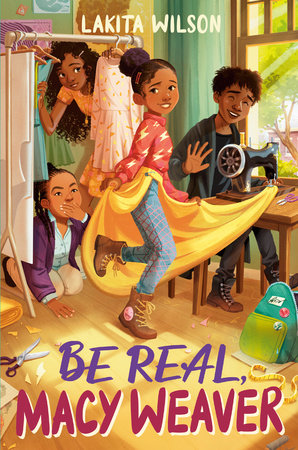 If you’re looking for a middle grade novel that seamlessly weaves the struggles of forging and maintaining friendships with fashion and fun, and makes readers laugh while also touching their hearts, Lakita Wilson’s debut middle grade novel, Be Real, Macy Weaver (Viking Books for Young Readers, July 12, 2022) is a pure delight. While it’s true that the author is my friend, a fellow Revisionary with whom I graduated from Vermont College of Fine Arts with an MFA in Writing for Children and Young Adults, hearing her work read aloud and interviewing her during our graduate residency told me she was one to watch. Her debut has met all my expectations. It is as beautiful on the inside as it is on the outside, and I have no doubt it’ll resonate with readers, young and old, as well as seasoned and aspiring writers studying their craft.
If you’re looking for a middle grade novel that seamlessly weaves the struggles of forging and maintaining friendships with fashion and fun, and makes readers laugh while also touching their hearts, Lakita Wilson’s debut middle grade novel, Be Real, Macy Weaver (Viking Books for Young Readers, July 12, 2022) is a pure delight. While it’s true that the author is my friend, a fellow Revisionary with whom I graduated from Vermont College of Fine Arts with an MFA in Writing for Children and Young Adults, hearing her work read aloud and interviewing her during our graduate residency told me she was one to watch. Her debut has met all my expectations. It is as beautiful on the inside as it is on the outside, and I have no doubt it’ll resonate with readers, young and old, as well as seasoned and aspiring writers studying their craft.
Here’s a brief description and synopsis of Be Real, Macy Weaver from Wilson’s website:
A humorous, heartfelt, and fashion-filled middle grade contemporary novel about Macy Weaver, a young girl struggling with how to be her true self and make a best friend—during a tumultuous year when her mom goes back to college. Perfect for fans of From the Desk of Zoe Washington and Stand Up, Yumi Chung.
Eleven-year-old Macy Weaver knows relationships are complicated. Fresh off her latest friendship breakup, she’s spent most of her summer break on her own. So, when Macy’s mother decides to go back to college three states away, Macy jumps on the chance to move—anything for a fresh start.
But Macy’s new home isn’t exactly what she expected. Her mother’s never around and her dad’s always working. Lonelier than ever, Macy sets her sights on finding a new best friend. When she meets Brynn, who’s smart and kind and already seems to have her whole life figured out—down to her future as a high fashion model—Macy knows she’s it. The only problem is that Brynn already has a BFF and, as everyone knows, you can only have one.
Resorting to old habits, Macy turns one small lie into a whole new life—full of fantastic fashion and haute couture—but it isn’t long before everything really falls apart. Ultimately, Macy must determine how to make things right and be true to herself—rather than chasing after the person she thinks she’s supposed to be.
I had the pleasure of doing a Q & A with Wilson as below.
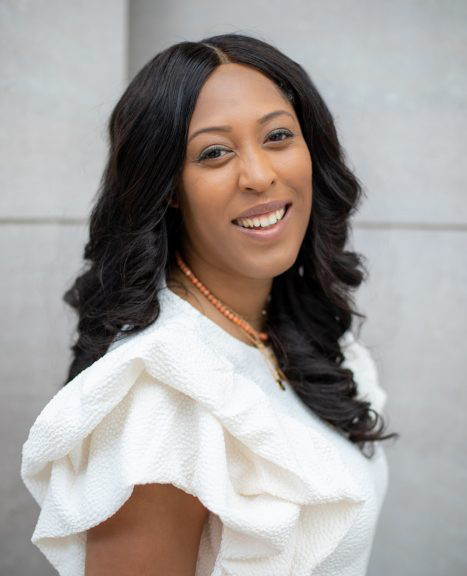 Which came first — Macy Weaver, the character, or her story? And what compelled you to write the story for middle grade readers in particular?
Which came first — Macy Weaver, the character, or her story? And what compelled you to write the story for middle grade readers in particular?
Let’s see…I remember brainstorming ideas for my next novel, and the theme of wanting best friendship kept popping into my mind. I wanted to write about a girl who wanted to be best friends with someone, and couldn’t. I remember giving Macy (my main character) a non-human friend first—Charlotte, the spider. Then, I set most of Macy’s story in a thrift shop, where she liked to hang out. In the final version of BE REAL, MACY WEAVER, the spider’s role has been reduced and the thrift shop scenes are gone. So, I guess you could say the character came first, because most of the story elements from the first draft are no longer there. Haha!
I’ve wanted to write middle grade most of all, because my memories from my own middle grade years are the strongest. The growing pains were so real at that age, that I naturally connect and empathize with children still going through it.
Friendships can be fabulous, but they can also be fraught—and fleeting. Is there anything you learned about yourself and your own friendships/the role of such relationships in your life (past and/or present), when you were on Macy’s journey?
Writing Macy’s friendship story forced me to look back at my own friendship journey, and how difficult it was to find my own community. Much like Macy, I think when I started to appreciate my authentic self more, the right friends naturally found their way to me—instead of me having to seek them out.
You write everything under the sun—nonfiction chapter books, middle grade and young adult novels. You’re also one of the most productive people I know (one who has often written at 5 a.m.—God bless you). Give us a glimpse of your typical writing life when you’re drafting and revising and how you fit it into your life/prioritize it in the context of being a professor and having family and other responsibilities.
Writing at 5am becomes less and less true every day, lol! I really wish I could go back to my 5am Writing Club schedule, but the pandemic has thrown my sleep schedule completely off. These days, I actually get the most writing done when I plan for an overnight writing sprint.
Typically, I write during the day, unless I’m teaching at the college, which is a few days a week, during fall and spring semesters. I try to stick to a solely teaching day/solely writing day schedule so that each has my full attention. I love teaching and I love writing, and I would like to continue the two, forever. But, I definitely have to give each their own time.
As far as the writing process, I can revise anywhere—especially on my couch, after a midday snack. I love revisions. But drafting is harder. Sometimes, I go away to draft, or I choose to draft strictly overnight—while the world sleeps—so I can really get in the zone and live the story right along with my characters. It’s a little spooky actually, because sometimes I can put myself so far into that head space, that I’ll look off to my right, expecting to see Pax or Grace walk by. Don’t believe me? Try writing at 3am. The silence will mess with you!
What’s the best writing advice you’ve ever received or that you can offer to new and seasoned writers from both a craft and business perspective?
Most recently, I’ve found that launching a novel can be a bit of a distraction. Before the books actually publish, it’s just you and your manuscript—no outside feedback except what happens between you and your editor—which still feels very much like a safe space. But, once people know a book is coming out, and they see the cover, and reviews start coming in, it’s very easy to refocus on that part, and suddenly—at least for me—you find yourself googling reviews instead of writing the next novel. It’s a very slippery slope!
Every writer I’ve talked to who has published books warned me of this pitfall—of becoming too consumed with every morsel of feedback—because good or bad, it will mess with you, and eventually take away from your writing time. And to make it long term in publishing, you have to continue writing, and focus most of your energy on that next project. It’s probably one of the few areas where writers have a bit of control.
What’s next for you in the kidlit space?
I’m currently working on my debut young adult novel, Last Chance Dance, which will hit shelves on February 21, 2023 as well as my second middle grade novel, which will also be published in 2023.
To learn more about Lakita Wilson and her wonderful work, visit her website.
Lakita Wilson is the author of several novels and nonfiction projects for children and young adults, including What Is Black Lives Matter? a part of the New York Times bestselling Who HQ Now series, and Be Real, Macy Weaver.
Lakita was born in Washington, DC, and grew up in Prince George’s County, Maryland. A 2017 recipient of SCBWI’s Emerging Voices Award, Lakita received her MFA in writing for children and young adults from Vermont College of Fine Arts. She is currently on faculty at Prince George’s Community College in the education department. Lakita lives in Prince George’s County, Maryland, with her two children and shih-tzu. She can be found on twitter at @LakitaWrites.
Elisa Zied a writer for young people. She holds an MFA in Writing for Children and Young Adults from Vermont College of Fine Arts and an Advanced Graduate Certificate in Children’s Literature from Stony Brook Southampton. She also earned a BA in psychology from University of Pennsylvania and an MS in clinical nutrition from New York University. Before embarking on a fiction writing career, she garnered millions of media impressions as a nutrition expert, spokesperson, and freelance health and nutrition writer. She also authored four award-winning nutrition titles including Younger Next Week (Harlequin Nonfiction, 2014) and Nutrition At Your Fingertips (Alpha Books/Penguin, 2009). She lives in New York City with her husband and two sons and is an avid walker, music lover, and extremely amateur photographer.
by Elisa Zied | May 4, 2022 | books, fiction, middle grade novels, writer, writers, writing
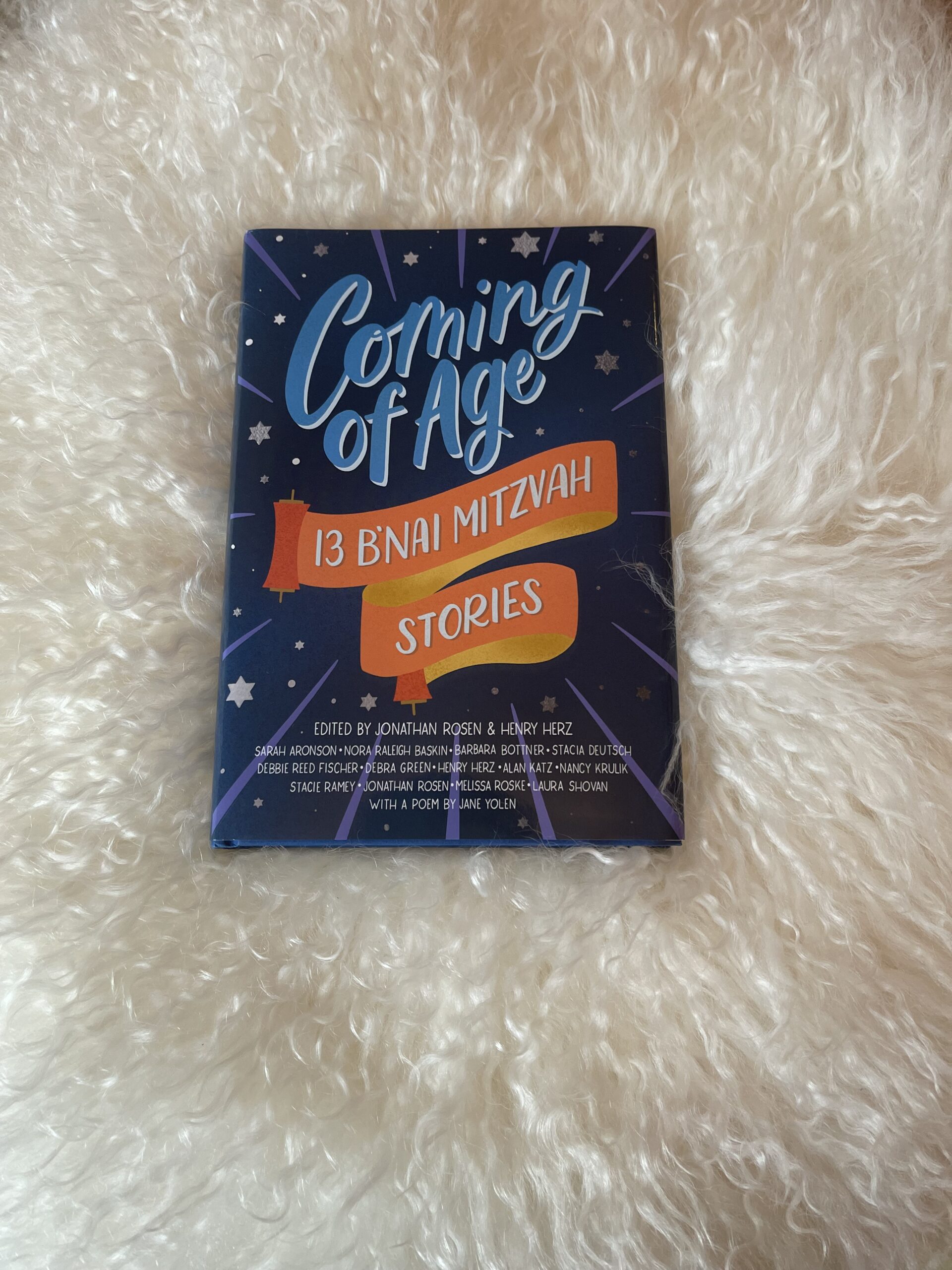 The moment I read about Coming of Age: 13 B’Nai Mitzvah Stories (Albert Whitman & Co., April 19, 2022), an anthology edited by Jonathan Rosen and Henry Herz, I knew it would be a must-read—and not just for its intended audience of 8 to 12-year-olds. Maybe the idea of the book made me nostalgic for my own bat mitzvah celebration that featured sparkly rainbow/unicorn centerpieces. Maybe it reminded me of the feeling of accomplishment after performing on the bimah after several months of practice alongside my friend Melissa. Maybe it was about remembering the party following my service, especially the rush of a slow dance with a cute boy to some early 80s ballad, or the fun of playing games like Coke and Pepsi and musical chairs with my school, camp, and family friends.
The moment I read about Coming of Age: 13 B’Nai Mitzvah Stories (Albert Whitman & Co., April 19, 2022), an anthology edited by Jonathan Rosen and Henry Herz, I knew it would be a must-read—and not just for its intended audience of 8 to 12-year-olds. Maybe the idea of the book made me nostalgic for my own bat mitzvah celebration that featured sparkly rainbow/unicorn centerpieces. Maybe it reminded me of the feeling of accomplishment after performing on the bimah after several months of practice alongside my friend Melissa. Maybe it was about remembering the party following my service, especially the rush of a slow dance with a cute boy to some early 80s ballad, or the fun of playing games like Coke and Pepsi and musical chairs with my school, camp, and family friends.
As I think about the trajectory of my own Judaism, I realize that all the rituals and practices from my childhood I had probably taken for granted took on so much more meaning as an adult as my husband and I tried to pass those on to our sons. And as we watched our boys read from the Torah and recite their d’var Torahs on the bimah in front of all four of their grandparents, and our family and friends, we could not be more proud.
Jewish or not, I hope you’ll check out this anthology, a great window into this rite of passage, and share it with your middle grade children and students.
I asked contributors of the anthology why they wanted to share their story, and what their bar or bat mitzvah taught them about Judaism or humanity. Here are some of their responses:
Melissa Roske, author of Kat Greene Comes Clean (Charlesbridge, 2017):

I’ve always felt that Jewish kids would benefit from an anthology like this one, so when Jonathan asked me to contribute a story to COMING OF AGE it was a no-brainer for me to to say YES!
In terms of what my bat mitzvah taught me about Judaism, well… that’s more complicated. I was extremely shy as a child, and speaking in public terrified me. Because of this, I focused on the actual reading of the Torah—of getting the words right, of not embarrassing myself in front of the congregation, or disappointing my parents—rather than on what the text actually meant. In many ways, I took Judaism for granted. Only later, after I’d had a chance to reflect on the experience, did I realize it was a privilege for me to become a bat mitzvah. To come of age as a Jew. It’s a shame I didn’t realize it at the time.
Nancy Krulik, author of more than 200 books for children and young adults, including three New York times bestsellers:
 I actually did not have a traditional bat mitzvah. My synagogue called it a “Bat Torah,” although we girls were not brought up to the bimah on Saturday to read from the actual Torah. Instead, we read a selection from the Book of Proverbs during the Friday night service. I was only the third girl in our congregation to have the ceremony. The “Bat Torah” was a compromise with our old-school rabbi, who did not feel women had any place on the bimah at all. It was a hard-fought battle, led by many girls in the Hebrew school, and our equally fierce parents. Today, young women in that same congregation have full-fledged b’not mitzvah, and the cantor is a woman. So, I guess what I learned is that change is hard, and it may take a lot of time, but it does come. Never give up fighting for equality in all aspects of life.
I actually did not have a traditional bat mitzvah. My synagogue called it a “Bat Torah,” although we girls were not brought up to the bimah on Saturday to read from the actual Torah. Instead, we read a selection from the Book of Proverbs during the Friday night service. I was only the third girl in our congregation to have the ceremony. The “Bat Torah” was a compromise with our old-school rabbi, who did not feel women had any place on the bimah at all. It was a hard-fought battle, led by many girls in the Hebrew school, and our equally fierce parents. Today, young women in that same congregation have full-fledged b’not mitzvah, and the cantor is a woman. So, I guess what I learned is that change is hard, and it may take a lot of time, but it does come. Never give up fighting for equality in all aspects of life.
I am a strong believer in the importance of people seeing themselves represented in books. For Jewish kids, particularly those who don’t live in predominantly Jewish communities, reading the stories in this collection can help validate who they are, and show them that there are plenty of other soon-to-be 13-year-olds with the same questions and struggles. I wanted to be a part of a project that would provide Jewish kids with a mirror to look into with pride. But I also hope non-Jewish readers will pick up the collection and learn more about our faith. I truly believe the more we all learn about one another, the better the world will be.
Laura Shovan, award winning poet and author of several books for children including A Place at the Table (Clarion Books, 2020), co-written with Saadia Faruqui:
 There was a lot of family drama around my bat mitzvah. I wanted to write a story that captured that anxious feeling, but put a funny spin on it. To write “A Funny Thing Happened on the Way to the Bimah,” I studied farce, including the Stephen Sondheim musical, “A Funny Thing Happened on the Way to the Forum.”
There was a lot of family drama around my bat mitzvah. I wanted to write a story that captured that anxious feeling, but put a funny spin on it. To write “A Funny Thing Happened on the Way to the Bimah,” I studied farce, including the Stephen Sondheim musical, “A Funny Thing Happened on the Way to the Forum.”
My bat mitzvah was one of those times when I saw how important sharing the traditions of Judaism was to my family, especially my grandmother, Joy.
Barbara Bottner, author of over 40 books for children and young adults:
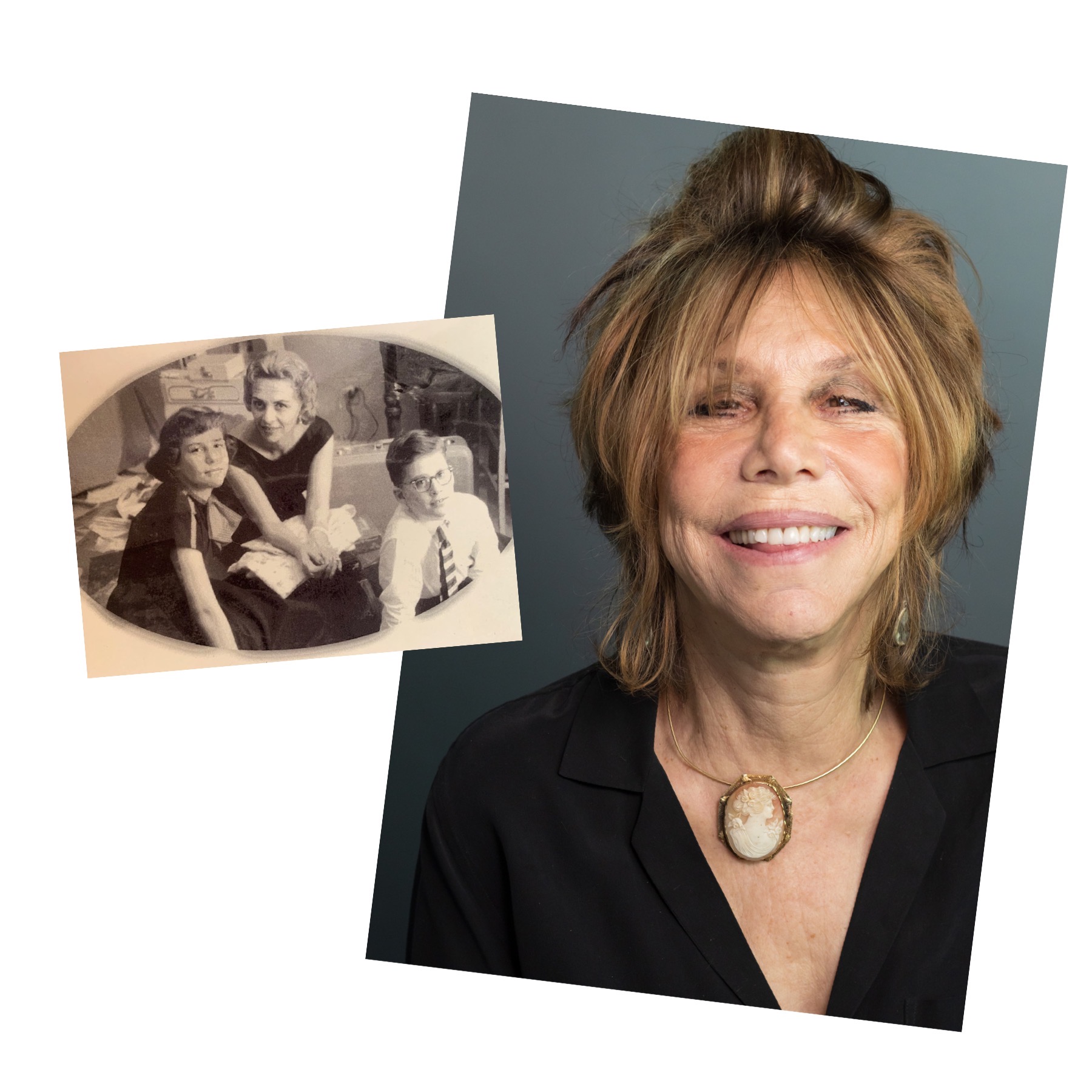 I’ve been wanting to do a Jewish-oriented story for a long time, so when I was invited to contribute to the anthology Coming of Age, it was an immediate yes. It was important for me to write something authentic, which is why I often write close to my own experiences. But my bat mitzvah was a by the book affair; there was nothing to draw on. So, I turned to history. I was fascinated to learn the first bat mitzvah in the country was in 1922 by Judith Kaplan, the daughter of a prominent New York City rabbi. That awakened my feminist leanings—why did it take so long, what kind of event was it? So, I investigated.
I’ve been wanting to do a Jewish-oriented story for a long time, so when I was invited to contribute to the anthology Coming of Age, it was an immediate yes. It was important for me to write something authentic, which is why I often write close to my own experiences. But my bat mitzvah was a by the book affair; there was nothing to draw on. So, I turned to history. I was fascinated to learn the first bat mitzvah in the country was in 1922 by Judith Kaplan, the daughter of a prominent New York City rabbi. That awakened my feminist leanings—why did it take so long, what kind of event was it? So, I investigated.
I learned that Kaplan’s bat mitzvah has already been covered. Bat mitzvahs took a while to take hold in the USA, so I wondered, what was the second such service like? Writing fiction, this was a delicious arena for a story. I set mine in the Lower East Side where I’d lived and also had acted in the Off-Broadway theater. I always felt kinship to the culture there, including the Jewish rialto, pulsing with the life of Yiddish humor, music and drama. I knew the blintzes from Ratner’s, and was familiar with the many family-owned businesses, and late-night spots. So, I invented almost thirteen-year-old Hannah, who’s the lone member of her outgoing, offbeat Yiddish theater family of actors. But Hannah is terrified to being onstage, due to extreme shyness. Not having been bathed in Sunday school, now she has questions about God’s treatment of females. She’s full of curiosity, loves her family, but has no rabbi to answer to; rabbi’s were busy with young men during this period. Luckily Hannah has her grandfather, a man of substance and a big heart, and he tutors her.
Wanting to deliver a relevant precedent for her Haftorah where females played an important part, I sleuthed through many to find one where two females, Jael and Deborah, act heroically to defeat Sisera and his armies. Then, I was ready to write. I tried to make it humorous. Jewish people are naturally good at humor and it connects to our resilience. Writing this was a great experience for me, so I hope it touches our readers.
Jonathan Rosen, co-editor of Coming of Age: 13 B’nai Mitzvah Stories and author of several middle grade books:

Well, since I helped put the anthology together, I figured contributing a short story was the right thing to do. But, seriously, I am very proud to be a part of Coming of Age. I thought it was important to have a place featuring Jewish stories, where Jewish kids could see themselves represented. I’m happy it’s out in the world.
I was fortunate enough to be living in Israel as a child, and had my bar mitzvah at the Western Wall. I remember even then of feeling the history and thinking about how many other Jewish kids had been at that spot for thousands of years. It just really resonated with me about the long line of history of the Jewish people, and the want to continue traditions and be a link in that chain.
Elisa Zied a writer for young people. She holds an MFA in Writing for Children and Young Adults from Vermont College of Fine Arts and an advanced Graduate Certificate in Children’s Literature from Stony Brook Southampton. She also earned a BA in psychology from University of Pennsylvania and an MS in clinical nutrition from New York University. Before embarking on a fiction writing career, she garnered millions of media impressions as a nutrition expert, spokesperson, and freelance health and nutrition writer. She also authored four award-winning nutrition titles including YOUNGER NEXT WEEK (Harlequin Nonfiction, 2014). She lives in New York City with her husband and two sons and is an avid walker, music lover, and amateur photographer.
by Elisa Zied | Mar 13, 2022 | books, fiction, MFA, middle grade novels, VCFA, writer, writers, writing, young adult books
Corey Ann Haydu has had quite a career. Besides being an amazing advisor in VCFA’s Writing for Children and Young Adults MFA program (I had the pleasure of working with and learning from her prior to doing the program as well as in my fourth semester), the acclaimed author has tackled everything from young adult and middle grade novels to chapter books to great effect with a combination of incredible skill in craft and her big, big heart. Her latest YA title, Lawless Spaces—her first novel in verse—is no exception. Here’s a brief description of the work that’s earned stars from Kirkus Reviews and Publisher’s Weekly, and is a Junior Library Guild Selection:
Perfect for fans of Deb Caletti, this poignant coming-of-age novel in verse follows a teen girl who connects with the women of her maternal line through their journals and comes to better understand her fraught relationship with her mother.
Mimi’s relationship with her mother has always been difficult. But lately, her mother has been acting more withdrawn than usual, leaving Mimi to navigate the tricky world of turning sixteen alone. What she doesn’t expect is her mother’s advice to start journaling—just like all the woman in her family before her. It’s a tradition, she says. Expected.
But Mimi takes to poetry and with it, a way to write down the realities of growing into a woman, the pains of online bullying, and the new experiences of having a boyfriend. And all in the shadows of a sexual assault case that is everywhere on the news—a case that seems to specifically rattle her mother.
Trying to understand her place in the world, Mimi dives into the uncovered journals of her grandmother, great-grandmother, and beyond. She immerses herself in each of their lives, learns of their painful stories and their beautiful sprits. And as Mimi grows closer to each of these women, she starts to forge her own path. But it isn’t until her mother’s story comes to light that Mimi learns about the unyielding bonds of family and the relentless spirit of womanhood.
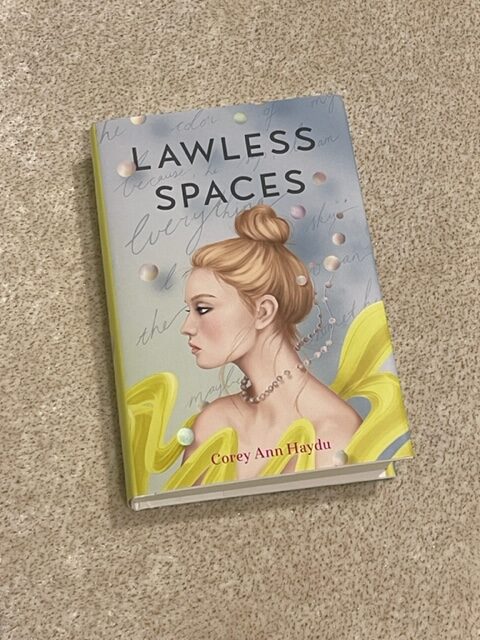 Poetry was a wonderful choice for Haydu’s poignant, heart-wrenching, and ultimately hopeful novel. It is raw, sometimes painful, and relatable to anyone who has ever felt trapped in their lives (such as during a pandemic), or trapped in/defined by their bodies, or powerless to speak out and make necessary change. Haydu explores mother/daughter relationships and all they entail (body image, power dynamics) across generations with courage and care, something that resonates with readers and reviewers alike.
Poetry was a wonderful choice for Haydu’s poignant, heart-wrenching, and ultimately hopeful novel. It is raw, sometimes painful, and relatable to anyone who has ever felt trapped in their lives (such as during a pandemic), or trapped in/defined by their bodies, or powerless to speak out and make necessary change. Haydu explores mother/daughter relationships and all they entail (body image, power dynamics) across generations with courage and care, something that resonates with readers and reviewers alike.
Haydu’s love of craft, her insight, and the amazing questions about living and life that she explores through her work give readers and writers alike a lot to ponder. Read on for her thoughtful and inspiring answers to our recent email Q & A:
What made you make the foray to writing a verse novel, and how did you prepare for that?
I’ve honestly always wanted to write in verse! Back in college my dream was to be an actress who published poetry on the side, and though many things changed about that dream over the years, my connection to poetry and the way a poem can so succinctly capture a moment and a feeling and get to the heart of things has remained the same.
I’ve been reading novels in verse basically since I first started reading in YA, sort of keeping in my back pocket the idea of them, loving that they existed, wondering if maybe I would get to wander over and try them myself some day. So the preparation was mostly that– years of reading them, and being excited by them, and understanding what makes them work. When it was time to actually write one of my own, I took it very slowly, just letting myself play with the form, long hand, and without a concrete plan for many years. It really helped to let myself stay in that exploratory phase for a long time.
 You now have various works published across so many genres (chapter books, middle grade and young adult novels (prose and verse). From creative and business standpoints, what have been the upsides of writing in so many different genres? Any challenges?
You now have various works published across so many genres (chapter books, middle grade and young adult novels (prose and verse). From creative and business standpoints, what have been the upsides of writing in so many different genres? Any challenges?
It’s hard to speak professionally, because I think that side of things is so unpredictable, and I tend to be a terrible judge of what will do well out in the world. But emotionally speaking, it has helped me a great deal to not have too much pressure on any one age category. My goal is always to get to focus on the writing– it’s the part of things I enjoy, and it’s the part I’m good at and suited for. And writing in multiple age categories lets me worry less about each individual book, once it’s out in the world. I worry about them a great deal when they’re in my hands, but once they come out, I’ve learned to let them go a bit, and focus on what’s next. There have been times my YA hasn’t been finding the readership I’d hoped for, and that’s why my middle grade started finding its space, and I’m so grateful I had that positive trajectory to focus on when certain books weren’t doing what I’d hoped.
Creatively, this is really just who I am. I like to try everything, writing-wise, I like to be challenged, and I’m inspired by every aspect of children’s publishing and storytelling generally. Feeling expansive and creative and out of my comfort zone really feeds me, and so far I have yet to get bored. I also have to say I’ve been incredibly lucky to have a supportive agent and supportive editors, who never told me I had to stay in one place. I’ve been encouraged to move around and explore other parts of my voice, and I don’t know why I’ve been given that chance, but i’m so glad I have, because it’s really how I work best.
 How has the pandemic impacted your writing life in terms of finding time and being in the headspace to do your best work? You’re obviously prolific and productive despite it all, so what has been most helpful to you in terms of getting it done?
How has the pandemic impacted your writing life in terms of finding time and being in the headspace to do your best work? You’re obviously prolific and productive despite it all, so what has been most helpful to you in terms of getting it done?
My number one current advice, especially for writers who also happen to be parents, but really for anyone who has a lot of demands on them in the home and is struggling to find their way creatively, is to get up early. I discovered 5am writing during the pandemic out of necessity– my toddler couldn’t handle me working while she was at home– and over the last two years every time I’m in a creative slump, I reintroduce that practice to myself. There’s something about writing before I have to be anyone else– a parent or a wife or a friend or a person in the world in any meaningful way– that really clarifies the work for me. I work faster, and better, and more enjoyably. I have found I need that, even though it can be tough. Once I’ve put on the parenting hat, it’s harder to transition into a creative space. So getting up very early is a gift I give myself as often as I can.
What was the spark for Lawless Spaces, and what do you hope readers glean from it?
I have long wanted to write a novel that follows mothers and daughters, that somehow tracks the things they are dealing with across generations. Maybe it all began with Gilmore Girls, and the incredible trifecta of Emilly, Lorelai, and Rory, and getting to see how baggage gets passed on and how it shifts and becomes something new. I have always wanted to understand that personally– and especially as I’ve become the mother of a daughter, those questions have gotten louder and more consuming for me. Once I started on that track, I realized it was time to write about a lot of things from my own life I hadn’t really addressed previously– specifically being a young girl in the entertainment industry, and living in a petite and curvy body, and how those things intersect with generational relationships and your own relationship with yourself. It was really an organic process, ultimately, where I found so much joy and healing.
As one of your former students who had the privilege to work with you, one of the things that most impresses me is your willingness to take risks in your writing, to wear your heart in so many of your gorgeous words, and your desire to keep pushing and keep learning. What books, films, music, craft resources etc. have influenced, helped, and inspired you most?
Honestly, poetry was a huge part of my teen years, when I was acting and writing, and also just struggling to put feelings into words and struggling to be understood. I was always deeply connected to the work of Sylvia Plath, as well as Pablo Neruda, Anne Sexton, and e.e. cummings. I loved their fearless and emotionally-forward approach to their work, and it not only resonated with me but helped me through really challenging times. Early on I was really blown away by Sandra Cisneros’ HOUSE ON MANGO STREET, which helped me understand the importance of small moments telling a bigger story. I’ve always been drawn to art that addresses difficult topics and challenging relationships. I was an actor, with a real affinity for the tragedy of THE GLASS MENAGERIE or the high-stakes ugliness of relationships in NO EXIT or the absurd takes on life of Christopher Durang’s work. I practically lived inside The Counting Crows’ first album, AUGUST AND EVERYTHING AFTER, which is a lyrically really heartbreaking and beautiful collection of songs– I loved how language and vulnerability combined to really make me feel understood in my pain.
I operate sort of heart-first, emotions-first with my work, and I certainly learned that from knowing what I connected with, and more than that probably what I needed. And that remains true– I like work that challenges me and stories that make me uncomfortable and language that makes me think about something anew. I’m also a collaborator, so I’ve been really influenced by the editors I’ve worked with, who have been really game to help me try new things and stretch into new spaces. I’ve found that caring more about learning than about being good at something is a real gift in a creative life. 🙂
Anything else you’d like to share?
Thanks so much for a such a smart, interesting collection of questions, and I hope the readers who are interested in the same things I’m interested in– bodies and mothers and daughters, and generational trauma, and how to push against the way the world sees you to be able to instead occupy the space that feels right for you– find LAWLESS SPACES. It was one of my favorite books to write, and I said so much I’ve been wanting to say, which always feels good.
To learn more about Corey Ann Haydu and her work, visit her website here. Lawless Spaces and her other books are available at Indiebound, Barnes & Noble, Amazon, or wherever books are sold.
Corey Ann Haydu is the author of many critically acclaimed middle grade and young adult novels, including EVENTOWN, RULES FOR STEALING STARS, EVER CURSED, and OCD LOVE STORY. She is also the author of the HAND-ME-DOWN MAGIC chapter book series. Corey is a graduate of NYU’s Tisch School of the Arts and The New School’s Writing for Children MFA program, and has been working in children’s publishing since 2009. In 2013, Corey was chosen as one of Publisher Weekly’s Flying Starts. Her books have been Amazon Book of the Month Selections, Junior Library Guild Selections, Indie Next Selections, and BCCB Blue Ribbon Selections. In 2020, she received an Edgar Award Nomination for her novel EVENTOWN. Corey is also a proud faculty member of the Vermont College of Fine Arts’ MFA in Writing for Children and Young Adults program. Corey lives in Brooklyn with her husband, her daughter, her dog, Oscar, and a wide variety of cheese.
Elisa Zied a writer for young people. She holds an MFA in Writing for Children and Young Adults from Vermont College of Fine Arts and an advanced Graduate Certificate in Children’s Literature from Stony Brook Southampton. She also earned a BA in psychology from University of Pennsylvania and an MS in clinical nutrition from New York University. Before embarking on a fiction writing career, she garnered millions of media impressions as a nutrition expert, spokesperson, and freelance health and nutrition writer. She also authored four award-winning nutrition titles including YOUNGER NEXT WEEK (Harlequin Nonfiction, 2014) and NUTRITION AT YOUR FINGERTIPS (Alpha Books/Penguin, 2009). She lives in New York City with her husband and two sons and is an avid walker, music lover, and amateur photographer.
by Elisa Zied | Oct 23, 2021 | books, fiction, writer, writers, writing, young adult books
If you’re looking for an immersive, beautiful and expansive story about friendship (with romance), Laura Taylor Namey’s third novel, When We Were Them (Atheneum Books for Young Readers, November 16, 2021), more than fits the bill. Told over the course of one week and laced with rich memories and moments between three friends, the story is sure to resonate with teens and adult readers alike who have experienced or aspired to have deep, meaningful relationships.
Here’s a description of the novel from Taylor Namey’s website:
When they were fifteen, Willa, Luz, and Britton had a friendship that was everything.
When they were sixteen, they stood by one another no matter what.
When they were seventeen, they went through the worst.
And when they were eighteen, Willa ruined it all.
I had the pleasure of doing a Q & A with Taylor Namey, an author I’m also proud to call a friend since we met years ago at the SCBWI annual conference in Los Angeles. Here are the highlights from our email exchange.
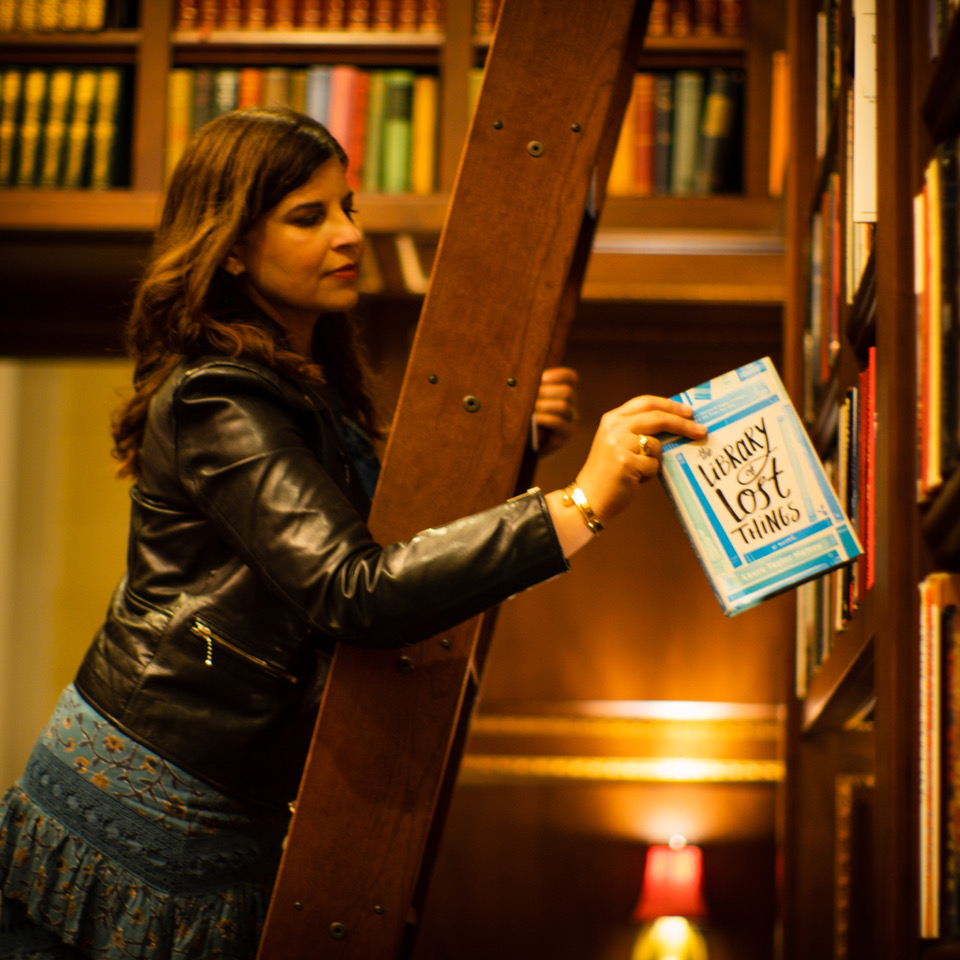 In what ways has your writing process and daily practice changed since writing your debut novel, The Library of Lost Things?
In what ways has your writing process and daily practice changed since writing your debut novel, The Library of Lost Things?
Now that my children are older, I definitely have more time to work in longer chunks, but my workload has increased ten-fold. I think what has changed the most is having to adapt to various seasons. My day looks much different when I’m actively drafting to other times when I’m focusing mainly on promotion or editing. My new motto is a combination of a day-by-day mentality as well as completing new tasks as quickly as I can, so they don’t pile up.
What was the spark for your latest novel, When We Were Them, and what made you want to explore female friendship?
After writing two coming of age YA novels with heavy romance subplots, I wanted to stretch my wings a little and try something different. WHEN WE WERE THEM is my most complex work to date, but I felt ready for a challenge. Having a brilliant editor who knew how to push and bring out my best made all the difference.
While A Cuban Girl’s Guide to Tea and Tomorrow is a tribute to my Cuban family, WHEN WE WERE THEM is an ode to my California beach girl childhood. I set the novel in the small community where I grew up. As a teen, my female friends and those relationships were so crucial to my identity and development. I wanted to celebrate a ride or die friendship between three teen girls, but also explore the way grief and loss and growing up can affect relationship, as well as the fallout that ensues when one girl leans too hard on the others. The novel asks the question, is everything they were strong enough to survive everything they’ve become?
While all of WWWT comes from you, which specific parts of which characters are most like or drawn from your family and friendships (childhood and/or current)?
These three characters and their friendship contain bits of me, in contrast to the character of Lila Reyes from A Cuban Girl’s Guide to Tea and Tomorrow. She embodies most me as a teen. Future opera star Britton shares my love of music, and Luz’s obsession with the heart and the human body and medicine is a tribute to my father who passed away from heart disease. Willa’s surfer girl and ocean loving spirit comes right from my childhood. I grew up on the beach featured on the cover.
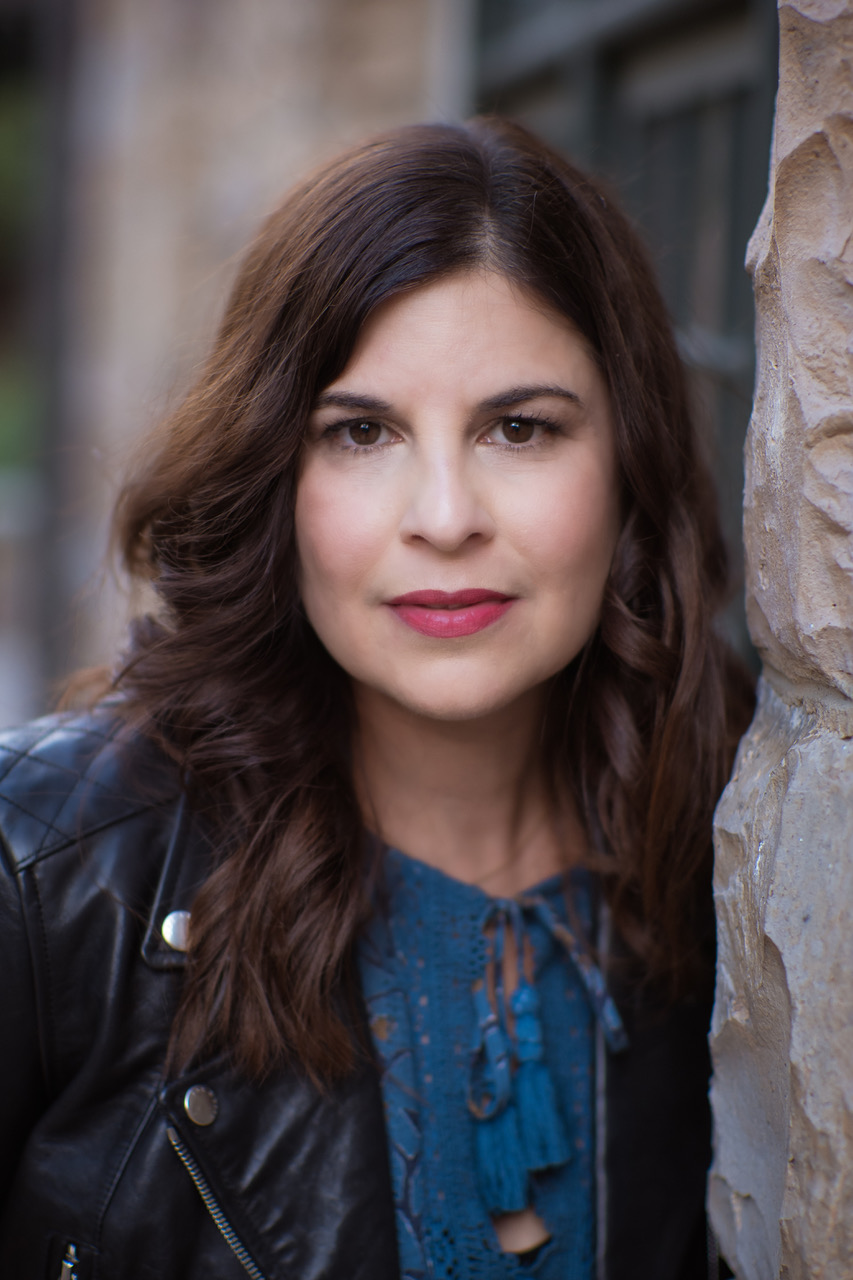 You dive deep into the ocean (pun intended), medicine, opera, becoming a Navy SEAL, and so much more in your novel. What did you know about each of these ahead of time, and what kind of research did you have to do before/while writing WWWT?
You dive deep into the ocean (pun intended), medicine, opera, becoming a Navy SEAL, and so much more in your novel. What did you know about each of these ahead of time, and what kind of research did you have to do before/while writing WWWT?
I knew very little about each of these aspects of my book, beyond surface level, before I started researching. Growing up in San Diego, I was familiar with Navy SEALs, used to live next door to a former SEAL. But it took interviews with active military personnel and a lot of reading to educate myself well enough to be able to include this experience in my story. The rest just took time and study, and a lot of YouTube watching. I particularly enjoyed watching hours of opera masterclasses and teaching sessions filmed at universities. Opera is such a gorgeous art form and it was a privilege to include a bit of this rep in my story.
You seem to be a master of juggling book drafting and revision as well as book promotion. What’s your typical schedule (or secret)?
Thank you! When I’m in a drafting or promotion season, or lately, both at once, I work between eight and ten hours a day. I draft in short 45-minute increments, spending the last fifteen minutes of every hour answering emails, prepping material for workshops, or maintaining my social media accounts. After dinner, I’m usually reading or working on my critique partners’ work. I’ve tried to be better about taking weekends off, but the month before a new book comes out, I typically have to spend a few weekend hours catching up. Despite the long hours, there is nothing I’d rather be doing.
Anyone who knows you knows how connected you are to your two critique partners. How has that relationship evolved and grown as you’ve all moved from pre-published writers to agented and/or published authors?
Now that the three of us have worked on multiple projects over the last three and a half years, I feel we’re better equipped to provide support, developmental feedback, and pinpoint editing within our workspace. We are the best of friends and mutual cheerleaders, and we trust each other implicitly. I am so lucky to have them.
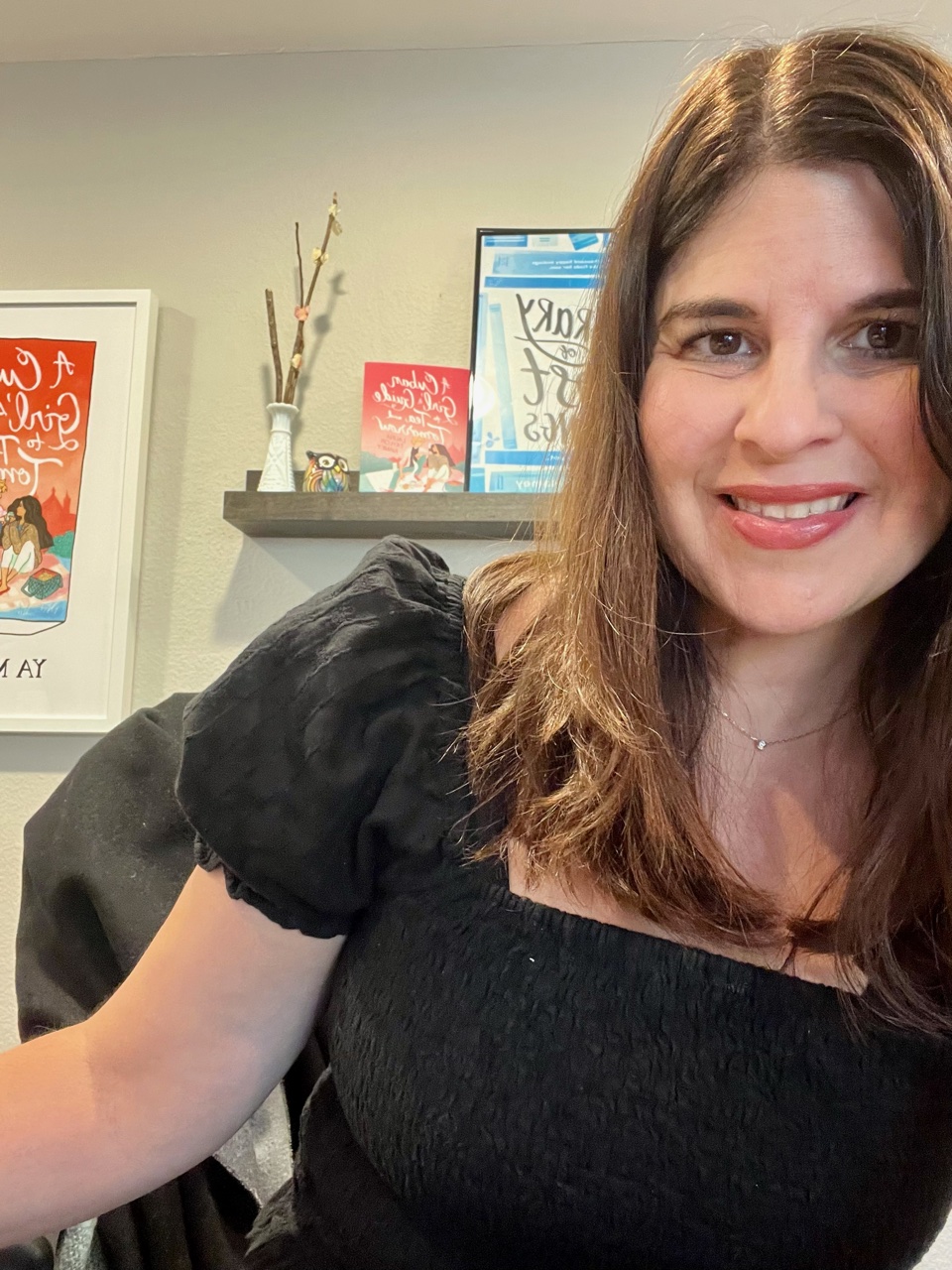 What was the best part about having your sophomore novel, A Cuban Girl’s Guide to Tea and Tomorrow, become a Reese’s YA Book Club pick—and a New York Times bestseller?
What was the best part about having your sophomore novel, A Cuban Girl’s Guide to Tea and Tomorrow, become a Reese’s YA Book Club pick—and a New York Times bestseller?
Being chosen for Reese’s Book Club has truly been one of the highlights of my career. The entire team is wonderful and so supportive, and the club works like a big family. I love being able to share my book across a wider platform and audience.
What has been the most challenging aspect of publishing three books in two years? And what have you learned about yourself as a writer (and a person) during that time?
Having to juggle multiple projects at once has been hard. Setting aside a draft to work on another book that might be in a different stage can be tricky. Now, I’m used to it. I’ve learned that I have a unique process that works for me and my writing style. And I’ve learned how much I truly love this job. The work is hard and long and taxing at times, but it is the only work I want to be doing.
What are some tips you have for aspiring writers to help them find ideas/inspiration for stories they’re meant to tell?
The world and the people you meet simply by living your life can provide so much inspiration. I’m also a fan of combining story ideas. The memory of a high school friend, plus a sparkling event three years ago, plus a curious letter or single line overheard at a café can be combined to create a thrilling new story. Also, ideas breed other ideas if you give them space. Jotting notes about story tidbits can unleash your creativity and many times, your mind will expand the scope of a few loose ideas into a novel worthy premise and a compelling tale.
Please share a favorite prompt or two for writers to help them get started on a new idea, or to get to know their characters better (especially those like me who are doing Nanowrimo in November).
My favorite exercise to get to know my character better is a long check list that I fiddle with before I start my book. Here is an abridged version. You should be able to answer these questions in your character’s voice.
I want most to:
I could have that except:
I am thrilled by:
I am inspired by:
I am terrified by:
I am disgusted by:
I’m most centered when:
I’m most anxious when:
My personal style looks like:
Not counting my pets, or family members, if I could only save three objects in a fire, I’d choose:
What are some of your favorite recent reads, TV shows, films or songs/albums?
Some recent favorite reads are You’d Be Home Now by Kathleen Glasgow, People We Meet on Vacation by Emily Henry, and Our Way Back to Always by Nina Moreno.
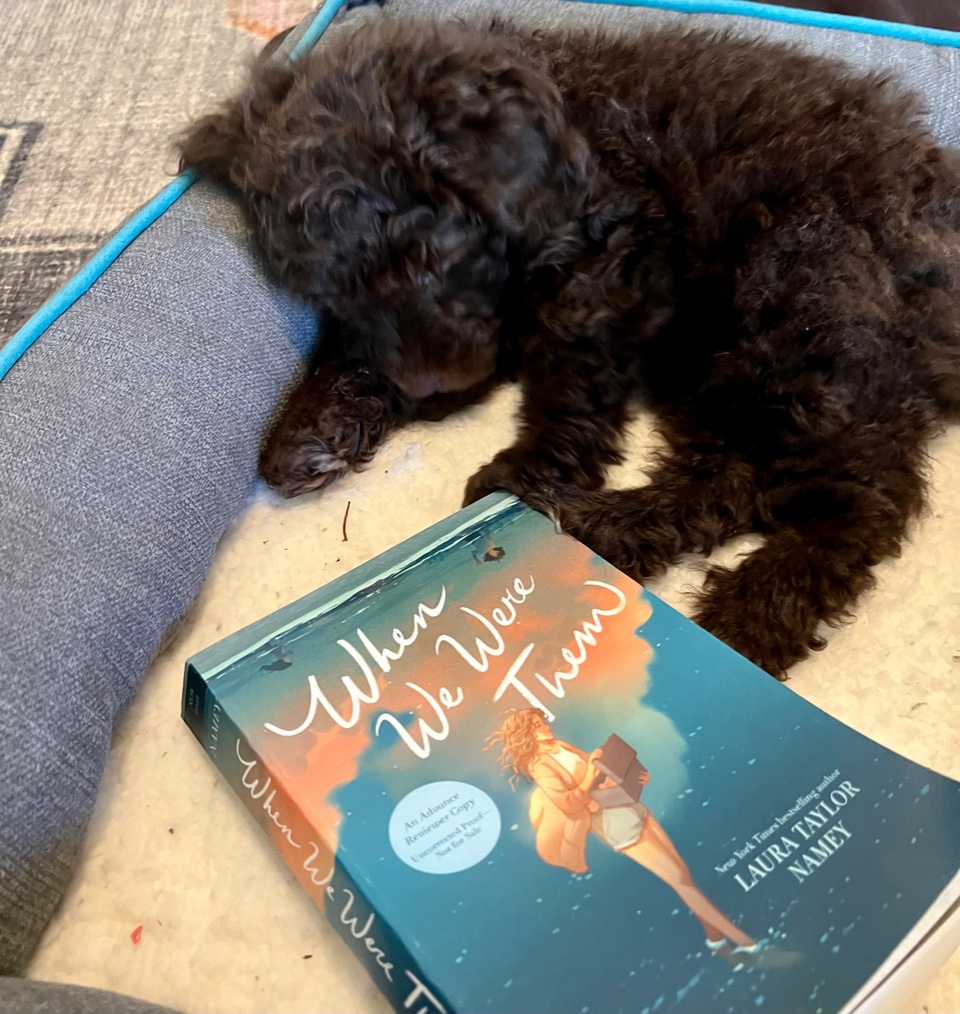
Professor Henry Higgins (aka Henry) is a big fan of his mother’s new novel!
Laura Taylor Namey is the New York Times bestselling author of Reese’s Book Club pick A Cuban Girl’s Guide to Tea and Tomorrow, The Library of Lost Things, and When We Were Them. A proud Cuban-American, she can be found hunting for vintage treasures and wishing she was in London or Paris. She lives in San Diego with her husband and two children. To learn more about Taylor Namey and all her work, visit her website here. You can order her books wherever books are sold, and check out her preorder campaign with Mysterious Galaxy Books in San Diego here.
by Elisa Zied | Sep 25, 2021 | books, fiction, writer, writers, writing, young adult books
You’d Be Home Now (Delacorte Press, September 28, 2021) is already a STAR. Kirkus calls the latest novel by bestselling author Kathleen Glasgow “A gut-wrenching look at how addiction affects a family and a town,” and “Necessary, important, honest, loving, and true.” Also praised by Booklist, and School Library Journal, this fantastic find according to Shondaland is at the top of my TBR list. I devoured Glasgow’s first two novels, Girl in Pieces and How to Make Friends with the Dark, and am especially excited for her latest work (which, for better or worse, makes me think of my own childhood). I have no doubt it will resonate with young adults and not so young readers alike. Here’s a brief description of You’d Be Home Now:
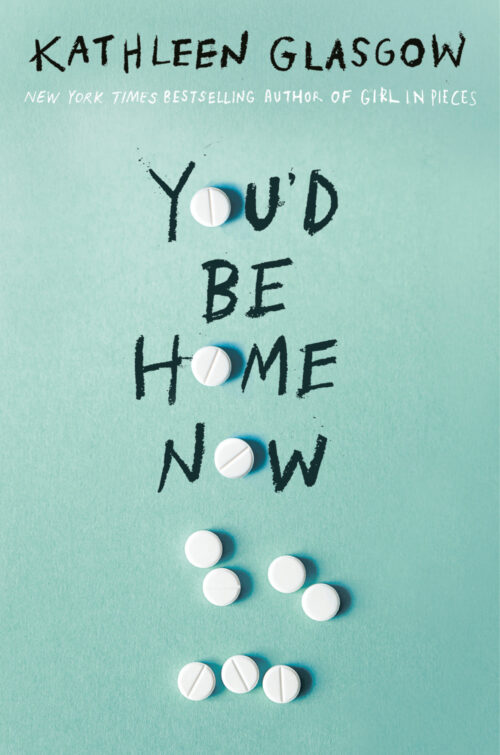 No one knew just how bad Joey Ward’s addiction was until the night Candy MontClaire died. Four months later, he’s back from rehab, hoping for a fresh start in a town that doesn’t know how to forgive. His sister, Emory, is tasked as his keeper. Because in a family with a “beautiful one” (her glamorous and outgoing older sister Maddie) and a “bad one” (Joey), Emmy has always been “the good one.” Of course she’ll keep her brother safe. She loves Joey more than anything. She’ll do anything to keep him alive.
No one knew just how bad Joey Ward’s addiction was until the night Candy MontClaire died. Four months later, he’s back from rehab, hoping for a fresh start in a town that doesn’t know how to forgive. His sister, Emory, is tasked as his keeper. Because in a family with a “beautiful one” (her glamorous and outgoing older sister Maddie) and a “bad one” (Joey), Emmy has always been “the good one.” Of course she’ll keep her brother safe. She loves Joey more than anything. She’ll do anything to keep him alive.
But what if love isn’t enough to save someone?
Glasgow was kind enough to do an email Q & A for my blog. Read on to learn more about her latest novel and her writing life.
What was the spark for You’d Be Home Now? And did you know from the get-go you wanted—or had to—write about a teen girl tasked with picking up the pieces after her brother’s drug addiction?
You’d Be Home Now was inspired by Thornton Wilder’s classic play, Our Town. It’s a loose reimagining of Grover’s Corners and what a town like that might be like today. If Wilder wrote the play today, I have no doubt the opioid crisis would be part of the plot, as this epidemic has ravaged families, towns, and communities. I chose to write the book from Emmy’s POV because there’s collateral damage in addiction: families, particularly siblings, who often become overlooked, overwhelmed, and exhausted in the face of a sibling’s addiction. The impact of addiction touches everyone in a family and really does a number on their mental health. They deserve a story, too.
I’m intrigued by the idea of examining who we are and what role we play within our families and our communities, and how that impacts our relationships and self-perception. I, for example, have always been a rule-follower who sought others’ approval, and who was always considered to be ‘the good one.” My older brother who was frequently in trouble was deemed “the bad one.” (We’ve been estranged for more than 15 years, and obviously haven’t worked through those narratives—maybe someday?!) What made you want to explore this idea in your novel, and did you have any revelations (in general or about your own life) along the way?
Everyone, for better or for worse, gets slotted into a role in a family: “the good one,” “the troubled one,” “the beautiful one,” “the difficult one.” It’s endless. But it’s not who each kid is, it’s who they are being defined as, and that’s not fair to any of them, because it makes them suppress emotions and not feel comfortable moving out of the role they’ve been assigned, if that makes sense. In YOU’D BE HOME NOW, Emmy is “the good one.” Quiet, rule-follower, caretaker of Joey since she was very small. In essence, because of this role, she’s never really discovered who she really is, or what she really wants out of life, or even how to get it. She doesn’t have an identity she forged on her own; it was given to her by her family. And of course, she wants to help her brother. But at what cost? She also wants to live a life of small, normal joys, like having a boyfriend, or going to dance. Those things make her feel guilty, though, because how can she enjoy herself while her brother’s life is disintegrating? I tried to be very careful in the book about Emmy’s journey with Joey, because she’s at the very beginning of this struggle with Joey, and many people (especially older readers) have reached a sort of end with the Joeys in their lives: they can no longer give all they’ve got; they’re exhausted. And that is valid! The question is learning to set your boundaries: what you can do, what you can’t do, because in the end, you also have to take care of yourself. It’s Emmy’s struggle in the book to realize this. I wanted to show the process of taking care of yourself, too. And to stop assigning people roles that don’t actually define who they are.
How was the process of writing this third novel different from that for Girl in Pieces, and How to Make Friends with the Dark?
Well, it was very hard to write with Thornton Wilder in the room! But I eventually overcame that, because the story became its own. I would say writing this book was different because Girl in Pieces and How to Make Friends with the Dark are pure emotion—Charlie and Tiger’s POVs are very interior and heavy. I needed to make Emmy’s narrative somewhat less intense than my other books to stretch the story beyond Emmy and into the town and the school to show how the tentacles of addiction ensnare everyone, not just the person struggling with addiction. An Instagram poster in the book called Mis_Educated is a character in the book and through their posts, a reader also gets a chance to hear from kids in the town of Mill Haven (in the comment section) about what’s really happening and how they feel about their lives.
How has the pandemic changed your writing life in terms of practices and inspiration?
I don’t know if the pandemic has changed my writing practice or inspiration so much as it has changed me, slowly, over time. I’m already an introvert and being even more isolated during the pandemic led me back into a deep depression. I wasn’t writing at all for several months, actually, until a joke between me and fellow author Liz Lawson (The Lucky Ones) turned into . . . a book. I needed something fun and different, I needed something to look forward to every day, and so did Liz, and those Twitter DMs between us eventually turned into a mystery called The Agathas, which comes out May 2022. Writing that book quietly with Liz, with no one watching (we didn’t tell our agents for a long time), really lifted me to a better place. And it’s a different tone of book for us, as both Liz and I tend toward heavier topics. We kept everything speedy, and fun, and about friendship (two teen girls become unlikely detectives and even more unlikely, become friends) and it was really a balm for me.
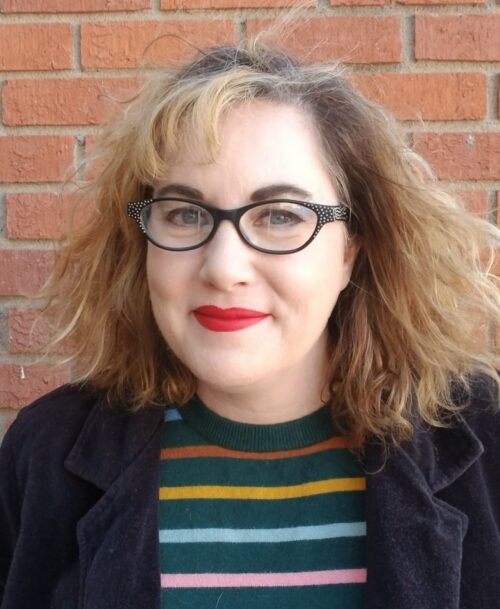 What has been the most rewarding part of being a young adult novelist? What has been the most challenging part?
What has been the most rewarding part of being a young adult novelist? What has been the most challenging part?
It’s rewarding in the sense that I hear every day from readers who have discovered Girl in Pieces and How to Make Friends with the Dark that those books have touched them deeply. I can’t really articulate what it means to know your book has impacted someone’s life in a deep and meaningful way. It makes me want to cry, actually! I’m grateful for that interaction. Writing is often hard and lonely, and sometimes you just don’t know if the story will land, especially with teens. I would say a challenging part is trying to do my best by teen readers and to articulate the adolescent experience in an authentic and believable way. And to give them a good and satisfying story to read.
What advice (in terms of craft or process) do you have for writers just starting out?
I don’t know if I’m an expert on anything having to do with writing, actually! I just try and write when I can, when a story keeps nudging me and won’t quit. I think in practical terms of craft, reading widely and often is the best teacher. You can learn from re-reading books you love: how the author structured this, how they handled that, how they went from A to B. I will say that you’ll learn what works for you in the beginning and then as you continue to write, you’ll improve through practice. I think the hardest thing for beginning writers is how to start. Like, literally, how to find time to sit in a chair (or couch, or bed, or coffee shop) and . . . get those first few words down. There’s a real fear: who am I to call myself a writer? Well, if you write, you’re a writer! And there’s a fear of: what if this isn’t any good? My answer to that is: what is good? One person might like your story, one might not. You can’t control that. But the most important thing to remember is, those things are abstract in the beginning: if you don’t sit down and write that story, no one will be able to read it. And believe me, someone wants to! Of that, I’m sure. We writers have a hard time getting out of our own way! We can imagine a million things might happen after we write a story and send it into the world, but if we don’t write it first, we will never know if any of those million things come to fruition.
What books, TV shows, and music have you most enjoyed during the pandemic (and more recently)?
I tend to have the television on in the background when I write and I wrote the entirety of You’d Be Home Now with Grey’s Anatomy on an endless loop. The shows I watched in the past two and half years when I WASN’T writing include (and I’m sorry on some of these because often it takes me years to watch a show everyone watched fifteen years ago): Game of Thrones, Mad Men, The Wilds, The Sopranos (could not finish, too many dream sequences), The Wire, 30 Rock, The Crown, Breaking Bad, Big Mouth, Forensic Files, Cold Cases, PEN15, Broadchurch. Some of my favorite books to read this past year were: The Lucky Ones (Liz Lawson); Never Saw You Coming (Erin Hahn); Something Happened to Ali Greenleaf (Hayley Krischer); When We Were Strangers (Alex Richards); That Weekend (Kara Thomas); The Project (Courtney Summers); Off the Record (Camryn Garrett). That’s just a small list. My music listening is all over the place, but lately I can’t stop listening to a song by Bright Eyes called “At the Bottom of Everything.” A weird thing about me is that while I don’t listen to music AS I write, I actually can’t start physically writing a book until I have everything in my head AND I have found the song that kind of drives the story, and “At the Bottom of Everything” is the song that drives what I hope will be my fifth book. (Girl in Pieces was “Kamera” by Wilco; How to Make Friends with the Dark was “Sign of the Times” by Harry Styles; You’d Be Home Now was “Let You Down,” by NF).
You’re a master storyteller, especially because you manage to inject hope into all of your stories no matter how raw, emotional, and painful they may have been to write or read. What’s one thing you’ve learned through your life and/or writing—especially during these especially challenging times—that has helped you persevere and continue to push through and make your art?
Honestly, I don’t know what else I would do if I couldn’t write. It’s all I’ve ever wanted to be, a writer. And stories are what keep us all going, right? When do we ever not need a good story?
About Kathleen Glasgow: She is the New York Times bestselling author of Girl in Pieces, How to Make Friends with the Dark, You’d Be Home Now, and the upcoming The Agathas (with Liz Lawson) (Delacorte, May 2022). She received her undergraduate degree from the University of New Mexico and her MFA from the University of Minnesota. She lives in Tucson, Arizona.
Check out my previous Q & A with Kathleen Glasgow for the launch of How to Make Friends in the Dark. And learn more about Glasgow and her work on her website. Her wonderful work is available wherever books are sold.
by Elisa Zied | Sep 12, 2021 | books, fiction, writer, writers
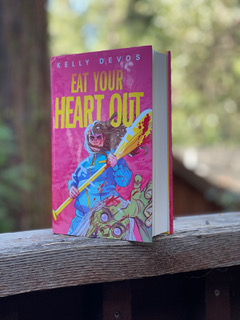 I’ve been following author Kelly DeVos’s career and enjoying her work and social media posts for years. I even had the pleasure of meeting the young adult writer at a pre-pandemic SCBWI conference in Los Angeles. Her latest novel, Eat Your Heart Out (Razorbill, June 2021), is smart, funny, satirical and original. Here’s a description of the novel, an Amazon Editor’s Pick in the Best Young Adult category:
I’ve been following author Kelly DeVos’s career and enjoying her work and social media posts for years. I even had the pleasure of meeting the young adult writer at a pre-pandemic SCBWI conference in Los Angeles. Her latest novel, Eat Your Heart Out (Razorbill, June 2021), is smart, funny, satirical and original. Here’s a description of the novel, an Amazon Editor’s Pick in the Best Young Adult category:
Eat Your Heart Out follows a group of six teenagers who are disgruntled at the prospect of being shipped off to a fancy fat camp during winter break. When they arrive at camp, they discover things are worse than they thought. The place is crawling with zombies. They may be the only six survivors and they have to both escape and figure out what’s really up with the mysterious pharmaceutical company running the camp.
I am thrilled to share this Q & A with deVos to celebrate her new novel as well as her timely and important work on body positivity, fat positivity and fat representation.
Your debut novel, Fat Girl on a Plane (Harlequin Teen, 2018), was written after an incident you experienced when you were about to board a flight. What happened, and how did it evolve into a young adult book?
Yes! I got the idea to write the book after I was asked to buy a second seat on a flight to Salt Lake City. Right around that time, I was contemplating giving my dream of becoming a published author another shot but I also happened to be working on setting up a photoshoot with Project Runway Season Four contestant, Keith Bryce. After leaving the show, Keith went on to set up a successful photography and wardrobe studio and I was headed there for a shoot.
I arrived at the Phoenix airport for my flight to Utah. The opening scene in my book was inspired pretty directly by what actually happened to me. I was told that I’d need to purchase a second seat. A lot of panicked questions raced through my mind. Could I afford the second seat? Did they even have one available? But most of all: Should I even go on the trip? For a moment, I couldn’t help but think that it would be less trouble and less humiliating to just stay home. I reminded myself that I had done a ton of work behind the scenes to make this shoot happen and I had as much right as anyone to be there. So, I got on the plane. But that experience was the genesis of my book. I kept wondering. Does fatphobia make us feel like we’re unworthy of pursuing our own dreams? I wanted to write not only about the way fat people are treated but also about how those negative experiences impact the choices that we make.
What inspired your subsequent novels (which include the duology Day Zero and Day One as well as Eat Your Heart Out)? How did your writing processes differ for each of these (and/or compared to your debut)?
After FAT GIRL came out, I was supposed to be working on another YA contemporary book, but I was having a lot of trouble. The 2016 election was in full swing. My awareness of a lot of issues had changed and, for me, the social and political climate, didn’t put me in a place where I was able to focus on upbeat writing. I wanted to change what I was doing. As I was changing to writing thrillers, I found I really liked that process quite a lot and I wanted to go more in that direction. I’ve always loved horror movies so I decided to lean into that genre and write EAT YOUR HEART OUT, which was such a blast to work on.
What is it about summer camp that made you want to write about it? What do you most remember about those days, and how did those experienced impact you as a person and a writer?
When I was growing up, we didn’t have a lot of money and I only got to go to summer camp once, but it was honestly the best experience ever. As a child, I was really scared of spiders. I still don’t like them now, but at that time I was absolutely terrified. The camp I went to had these pretty basic, VERY rustic, wooden cabins where six or eight kids could sleep on bunkbeds. The very first night I found an enormous spider in my bed and almost got hysterical.
They moved me into the cabins that they had for adults which were (to a ten-year-old) super luxurious. There was a private pool and a kitchen with free snacks and a queen size bed and air conditioning. It was fabulous. The other kids thought I was some kind of celebrity or something. I’d be out at camp during the day, doing arts and crafts and sitting by the campfire and then I’d go back to the fancy part and swim and snatch Oreos. I took a lot of inspiration from that experience into EAT YOUR HEART OUT. It was a camp setting for people who almost wanted to pretend to be camping rather than actually be roughing it.
You’ve written thoughtfully about body positivity in several publications, most notably The New York Times (May 2018). How has your thinking about it evolved since writing that article? And how does this translate into the messages you share (without being didactic of course) through your novels?
Body positivity, fat positivity and fat representation are all topics that are very near and dear to my heart. I continue to feel that there should be space for nuance in how we handle these issues, particularly in fiction. But I feel like what I have had to learn is that, as fat people, we’re not all in the same place in our journey to self-acceptance and self-love. So, I have tried to proceed with a lot more sensitivity to try to make sure that my material finds an audience who’s able to and interested in engaging with it. Using content warnings, describing the plot of my books very accurately and making sure that books that contain fatphobia (even just to condemn it) are marketed to prepared readers are things that I’ve gotten much more serious about.
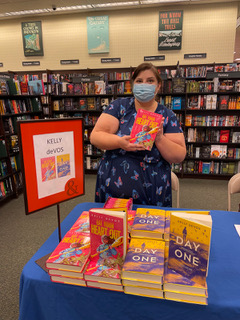 How has the pandemic impacted your writing, and how do you balance that with book promotion?
How has the pandemic impacted your writing, and how do you balance that with book promotion?
Possibly because I have been writing horror, I actually got quite a bit of writing done. Feelings of mortal terror have been coming quite naturally! During the pandemic, I’ve struggled with what, if anything, I could do to effectively promote my books. Many of the things I would have done in the past, like bookstore or library events, haven’t been paused due to COVID. In terms of balance, I try to prioritize writing. Beyond that, for promotion, I try to focus on things I enjoy. I mainly stay on social media channels I like and do things that are fun. That way, I am always satisfied with the use of my time.
What has been the best part of writing for young people?
Reading was so important to me growing up and I love the idea that my books are available for teen readers. I think the best part is getting to see my books find their way into the hands of teens and hope that they impact the readers’ lives in some way.
Any writing resources (books, podcasts, etc.) that you can’t live without?
I love Outlining Your Novel and the workbook that goes with it from K.W. Weiland. She also has a fantastic website (https://www.helpingwritersbecomeauthors.com) full of a ton of free resources for writers. For podcasts, I listen to What Book Hooked You with Brock Shelley which I find fascinating because authors talk about the books that inspired them to write. I also really like Writer Writer Pants on Fire with Mindy McGinnis. I’m a big fan of her work and I think she often has really interesting topics and guests.
Please share any advice that has helped you in your journey from writer to published author.
A couple things have really helped me. First of all, I’ve made some great friends who are writers and who really understand what the process is like. From being in the query trenches to finally have a book on shelves, it helps so much to have a support system. Second, I try to keep moving forward. I keep a couple of projects going at the same time and I try to do things to improve my craft.
I have one last question that’s completely tangential to book talk. I learned on your website that you have a sticker collection! One of the things I personally loved about sleep away/overnight camp was sharing with others and organizing my sticker and stationary collections. What are your tips for those (including me) who might want to revisit/reintroduce the popular pastime into our lives?
I basically live for stickers!! Just kidding. But I do like them an awful lot. Growing up, I absolutely loved all that Lisa Frank stuff. A few years ago, I saw an ad online for a sticker club and it dawned on me that I could collect stickers now too. Whenever I travel anywhere I pick up stickers and there are some local boutiques here in Phoenix that have incredible offerings. I was a member of the Pipsticks club for a while but I had to pause that a bit because I was running out of places to store my stuff.
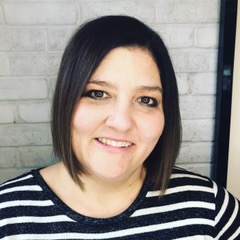 Kelly deVos is from Gilbert, Arizona, where she lives with her high school sweetheart husband, amazing teen daughter and superhero dog, Cocoa. She holds a B.A. in Creative Writing from Arizona State University. When not reading or writing, Kelly can typically be found with a mocha in hand, bingeing the latest TV shows and adding to her ever-growing sticker collection.
Kelly deVos is from Gilbert, Arizona, where she lives with her high school sweetheart husband, amazing teen daughter and superhero dog, Cocoa. She holds a B.A. in Creative Writing from Arizona State University. When not reading or writing, Kelly can typically be found with a mocha in hand, bingeing the latest TV shows and adding to her ever-growing sticker collection.
Her work has been featured in the New York Times as well as on Vulture, Salon, Bustle and SheKnows. Her debut novel, Fat Girl on a Plane, was named one of the “50 Best Summer Reads of All Time” by Reader’s Digest magazine.
Learn more about deVos on her website. You can also follow her on Twitter, on Instagram, and on Facebook. You can also learn more about her work on Goodreads. You can purchase Eat Your Heart Out from Amazon, B&N, Indiebound or wherever books are sold.
 If you’re looking for a middle grade novel that seamlessly weaves the struggles of forging and maintaining friendships with fashion and fun, and makes readers laugh while also touching their hearts, Lakita Wilson’s debut middle grade novel, Be Real, Macy Weaver (Viking Books for Young Readers, July 12, 2022) is a pure delight. While it’s true that the author is my friend, a fellow Revisionary with whom I graduated from Vermont College of Fine Arts with an MFA in Writing for Children and Young Adults, hearing her work read aloud and interviewing her during our graduate residency told me she was one to watch. Her debut has met all my expectations. It is as beautiful on the inside as it is on the outside, and I have no doubt it’ll resonate with readers, young and old, as well as seasoned and aspiring writers studying their craft.
If you’re looking for a middle grade novel that seamlessly weaves the struggles of forging and maintaining friendships with fashion and fun, and makes readers laugh while also touching their hearts, Lakita Wilson’s debut middle grade novel, Be Real, Macy Weaver (Viking Books for Young Readers, July 12, 2022) is a pure delight. While it’s true that the author is my friend, a fellow Revisionary with whom I graduated from Vermont College of Fine Arts with an MFA in Writing for Children and Young Adults, hearing her work read aloud and interviewing her during our graduate residency told me she was one to watch. Her debut has met all my expectations. It is as beautiful on the inside as it is on the outside, and I have no doubt it’ll resonate with readers, young and old, as well as seasoned and aspiring writers studying their craft. Which came first — Macy Weaver, the character, or her story? And what compelled you to write the story for middle grade readers in particular?
Which came first — Macy Weaver, the character, or her story? And what compelled you to write the story for middle grade readers in particular? 

 I actually did not have a traditional bat mitzvah. My synagogue called it a “Bat T
I actually did not have a traditional bat mitzvah. My synagogue called it a “Bat T There was a lot of family drama around my bat mitzvah. I wanted to write a story that captured that anxious feeling, but put a funny spin on it. To write “A Funny Thing Happened on the Way to the Bimah,” I studied farce, including the Stephen Sondheim musical, “A Funny Thing Happened on the Way to the Forum.”
There was a lot of family drama around my bat mitzvah. I wanted to write a story that captured that anxious feeling, but put a funny spin on it. To write “A Funny Thing Happened on the Way to the Bimah,” I studied farce, including the Stephen Sondheim musical, “A Funny Thing Happened on the Way to the Forum.” 

 Poetry was a wonderful choice for Haydu’s poignant, heart-wrenching, and ultimately hopeful novel. It is raw, sometimes painful, and relatable to anyone who has ever felt trapped in their lives (such as during a pandemic), or trapped in/defined by their bodies, or powerless to speak out and make necessary change. Haydu explores mother/daughter relationships and all they entail (body image, power dynamics) across generations with courage and care, something that resonates with readers and reviewers alike.
Poetry was a wonderful choice for Haydu’s poignant, heart-wrenching, and ultimately hopeful novel. It is raw, sometimes painful, and relatable to anyone who has ever felt trapped in their lives (such as during a pandemic), or trapped in/defined by their bodies, or powerless to speak out and make necessary change. Haydu explores mother/daughter relationships and all they entail (body image, power dynamics) across generations with courage and care, something that resonates with readers and reviewers alike. You now have various works published across so many genres (chapter books, middle grade and young adult novels (prose and verse). From creative and business standpoints, what have been the upsides of writing in so many different genres? Any challenges?
You now have various works published across so many genres (chapter books, middle grade and young adult novels (prose and verse). From creative and business standpoints, what have been the upsides of writing in so many different genres? Any challenges? How has the pandemic impacted your writing life in terms of finding time and being in the headspace to do your best work? You’re obviously prolific and productive despite it all, so what has been most helpful to you in terms of getting it done?
How has the pandemic impacted your writing life in terms of finding time and being in the headspace to do your best work? You’re obviously prolific and productive despite it all, so what has been most helpful to you in terms of getting it done? In what ways has your writing process and daily practice changed since writing your debut novel, The Library of Lost Things?
In what ways has your writing process and daily practice changed since writing your debut novel, The Library of Lost Things? You dive deep into the ocean (pun intended), medicine, opera, becoming a Navy SEAL, and so much more in your novel. What did you know about each of these ahead of time, and what kind of research did you have to do before/while writing WWWT?
You dive deep into the ocean (pun intended), medicine, opera, becoming a Navy SEAL, and so much more in your novel. What did you know about each of these ahead of time, and what kind of research did you have to do before/while writing WWWT?  What was the best part about having your sophomore novel, A Cuban Girl’s Guide to Tea and Tomorrow, become
What was the best part about having your sophomore novel, A Cuban Girl’s Guide to Tea and Tomorrow, become 
 No one knew just how bad Joey Ward’s addiction was until the night Candy MontClaire died. Four months later, he’s back from rehab, hoping for a fresh start in a town that doesn’t know how to forgive. His sister, Emory, is tasked as his keeper. Because in a family with a “beautiful one” (her glamorous and outgoing older sister Maddie) and a “bad one” (Joey), Emmy has always been “the good one.” Of course she’ll keep her brother safe. She loves Joey more than anything. She’ll do anything to keep him alive.
No one knew just how bad Joey Ward’s addiction was until the night Candy MontClaire died. Four months later, he’s back from rehab, hoping for a fresh start in a town that doesn’t know how to forgive. His sister, Emory, is tasked as his keeper. Because in a family with a “beautiful one” (her glamorous and outgoing older sister Maddie) and a “bad one” (Joey), Emmy has always been “the good one.” Of course she’ll keep her brother safe. She loves Joey more than anything. She’ll do anything to keep him alive. What has been the most rewarding part of being a young adult novelist? What has been the most challenging part?
What has been the most rewarding part of being a young adult novelist? What has been the most challenging part? I’ve been following author Kelly DeVos’s career and enjoying her work and social media posts for years. I even had the pleasure of meeting the young adult writer at a pre-pandemic
I’ve been following author Kelly DeVos’s career and enjoying her work and social media posts for years. I even had the pleasure of meeting the young adult writer at a pre-pandemic  How has the pandemic impacted your writing, and how do you balance that with book promotion?
How has the pandemic impacted your writing, and how do you balance that with book promotion?  Kelly deVos is from Gilbert, Arizona, where she lives with her high school sweetheart husband, amazing teen daughter and superhero dog, Cocoa. She holds a B.A. in Creative Writing from Arizona State University. When not reading or writing, Kelly can typically be found with a mocha in hand, bingeing the latest TV shows and adding to her ever-growing sticker collection.
Kelly deVos is from Gilbert, Arizona, where she lives with her high school sweetheart husband, amazing teen daughter and superhero dog, Cocoa. She holds a B.A. in Creative Writing from Arizona State University. When not reading or writing, Kelly can typically be found with a mocha in hand, bingeing the latest TV shows and adding to her ever-growing sticker collection.
Recent Comments